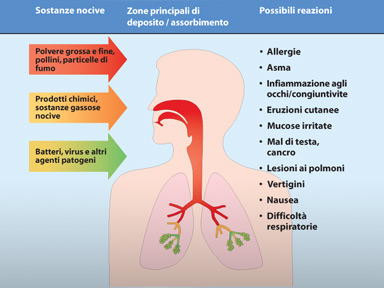
To understand where this disease we must explain that What is l’ Allergy. The’ allergy is an overreaction of the immune system to substances that are harmless to most organisms. All’ origin of’ Allergy there is an intensification of the normal immune reactions.
The immune system is the defense system of the’ the human organism, ready to intervene at any time: It recognizes the foreign substances with a high degree of perfection and has the task of producing antibodies to make this latest harmless. Allergic reactions play a considerable role, as hay fever or l’ allergic asthma.
Respiratory allergies involving immediate reactions, i.e. the symptoms escalate just minutes after contact with the’ allergen.
Triggers allergies
Very broad is the range that may trigger allergic reactions; This are classified as allergens.
Animal allergens: mammalian epithelial, feathers, insect body parts, body parts of domestic mites and copepod crustaceans (For example,: fleas (d)’ water).
Allergens of vegetable origin: pollen, cereal pulviscicolo, flour and bran, textile fibres, wooden pulviscicolo, mushroom spores, coffee beans, natural rubber, essential oils and herbs.
Allergens of chemical origin: epoxy resins, phthalic acid anhydride, Metallic salts, Isocyanates, enzymes and pulviscicolo of medicines.
Inhaled allergens indoors
The prevails the erroneous belief that the external environment is more polluted and that therefore are healthier staying in closed environments. Some studies refute everything because the main source of pollution of ’’ air is to be found in closed environments; among the major causes of allergies there are domestic mites.
The domestic dust is a mixture, the composition of which includes domestic mites and their droppings, mold spores, feathers, bacteria, pollen, hair and skin scales , animal hair fibres, It may not be entirely eliminated ever, but in the best-case scenario reduced.
Domestic mites are small organisms of microscopic size animals and their droppings cause allergic reactions. Some studies show that the 30% mites was found in mattresses, the 34% in bedspreads, 16% in padding and a 20% was found in carpets and floor coverings. In the dust from the beds have been found around 4000 mites per gram, but the concentration may be higher.
The main domestic dust deposits are: read, mattresses, pillows, upholstered furniture, carpets, carpet, libraries, curtains and plush toys.
The animal hair are particularly aggressive of allergens indoors, on average about ten owner reacts allergic to animal hair. Animals lose scales and hairs and animal saliva may trigger allergic reactions.
The pollen plays a very important role, which of indoor allergen, as with doors and Windows open, It is difficult to prevent all penetration of local and then pollen concentration is greater than.
Symptoms of allergies
Allergic reactions can be of various types depending on the mode the respiratory system.
Allergic colds: about 1/5 of the population suffers from allergic colds, that represent the most common form of respiratory allergy. The characteristics of allergic colds are: sneezing, itchy nose, leaking nose, nasal breathing difficult; This is also accompanied by ocular reactions including: watery eyes, itching, redness, burning eyes and respiratory tract reaction including: cough, shortness of breath and lack d’ air.
Allergic asthma: among the factors triggering the’ Asthma include; domestic dust, spray cosmetics and domestic, cooking steam, smoke, exhaust gas. The’ allergic asthma is characterized by wheezing accesses. A violent cough often accompanies the sensation of breathlessness; l’ exhale is difficult and is accompanied by boos, humming or noises various.
Allergic Alveolitis: It is a lung disease in which are not affected by the primary airway, but the pulmonary alveoli and surrounding tissue. Unlike’ asthma, the disease slowly manifested, accompanied by shortness of breath, cough, fever, chills and muscle pain. No disturbances occur immediately, but with a time ranging from 6 hours at 8 hours after the’ place contact with’ areoallergene. With persistent chronic illness becomes time and can cause severe lung damage secondary to heart.
How to recognize a’ Allergy
Various methodologies lead the doctor to diagnose a’ Allergy.
Among the most important methods include:
- The’ the patient's medical history
- Skin tests
- Search allergic antibodies in the blood
- Tests on isolated cells
- Provocation tests with suspected allergens triggers on the mucosa of the nose and bronchi.
In the diagnosis of allergies l’ history plays a crucial ’ as it can contribute significantly to identifying the cause of evil.
It is always the point of departure for further diagnostic investigation.






